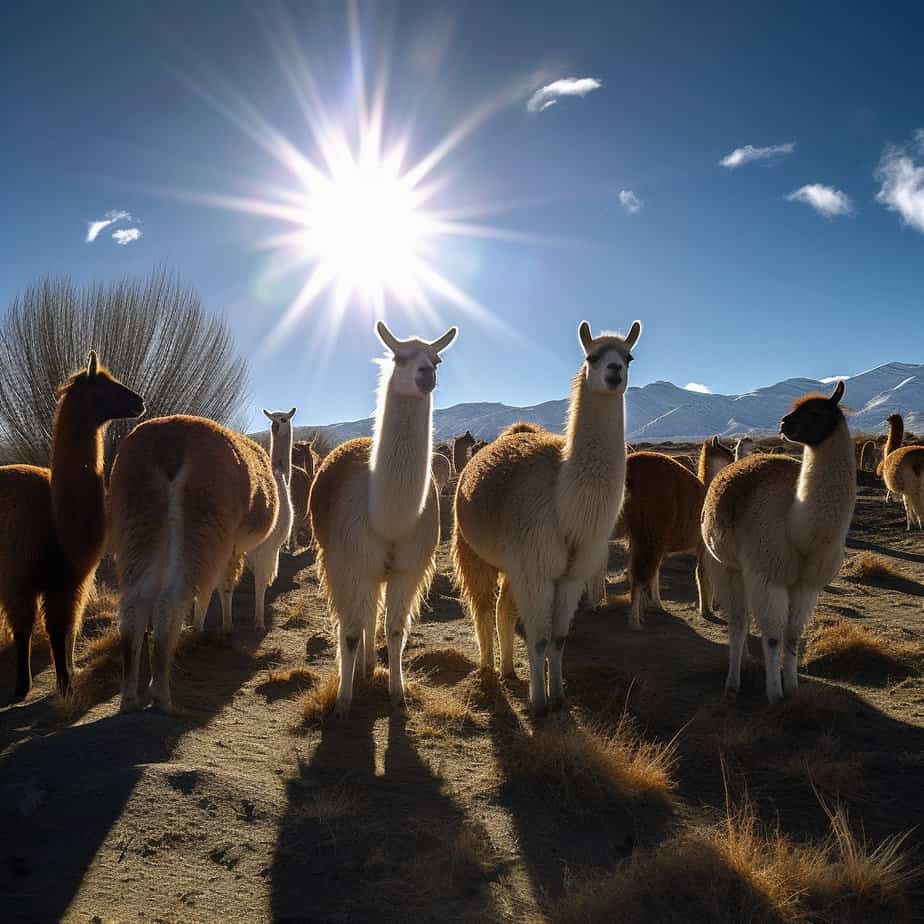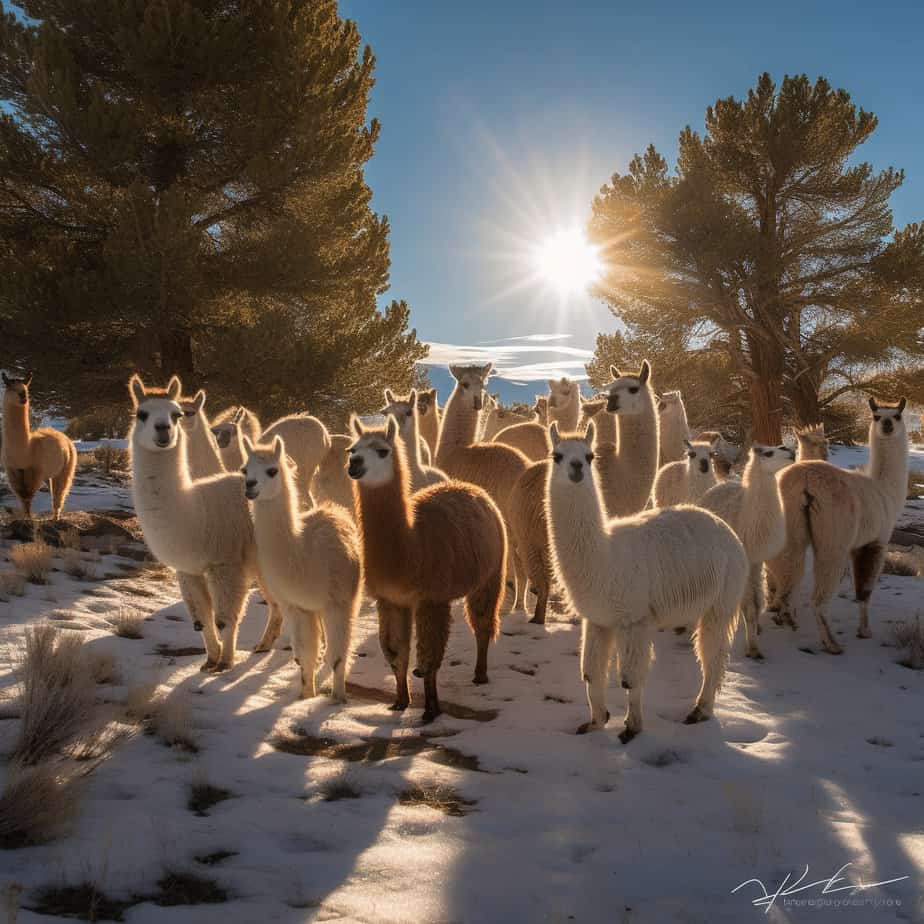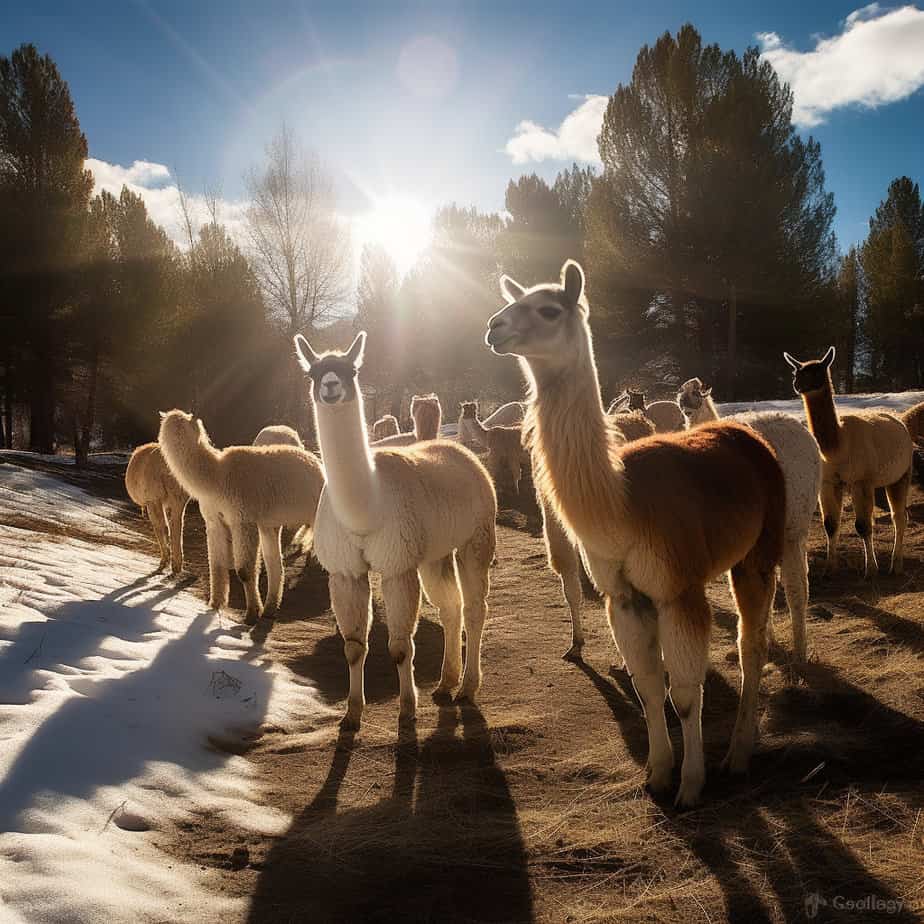Llamas are fascinating creatures known for their unique appearance and gentle demeanor. If you’ve ever encountered a llama, you may have wondered whether these animals shed their fur. Shedding is a natural process in many animals, including llamas, and it plays an important role in their overall health and well-being. In this article, we will explore the shedding patterns of llamas, why they shed, and how to properly care for their coats. So, let’s dive in and unravel the mystery of llama shedding!
Key Takeaways
- Llamas do shed their fur, typically once a year.
- Shedding usually occurs in the spring and summer months.
- Regular grooming can help manage llama shedding.
- Shedding is a natural process for llamas and helps them adapt to changing temperatures.
Understanding Llamas: An Overview

Llamas are fascinating creatures that have captivated the hearts of many with their unique appearance and gentle demeanor. In this section, we will provide a brief description of llamas and explore the difference between llamas and alpacas.
A. Llamas: A Brief Description
Llamas, scientifically known as Lama glama, are domesticated animals that belong to the camelid family. They are native to the South American Andes and have been an integral part of the region’s culture for centuries. Llamas are known for their distinctive appearance, with long necks, slender bodies, and large, expressive eyes.
These majestic creatures are highly adaptable and can thrive in a variety of environments, from high altitudes to harsh climates. They have a double coat of fur, consisting of a coarse outer layer and a soft, insulating undercoat. The outer coat helps protect them from the elements, while the undercoat keeps them warm during colder months.
Llamas come in a range of colors, including white, black, brown, and various shades of gray. They have a lifespan of around 15 to 25 years, depending on their overall health and care.
B. The Difference Between a Llama and an Alpaca
While llamas and alpacas may appear similar at first glance, there are some key differences between the two. Here are a few factors that set them apart:
-
Size: Llamas are generally larger than alpacas, both in terms of height and weight. Llamas can reach heights of up to 6 feet at the shoulder and weigh between 280 to 450 pounds, whereas alpacas are smaller, standing at around 3 feet tall and weighing between 100 to 200 pounds.
-
Purpose: Llamas were traditionally bred for their strength and endurance, serving as pack animals for transportation purposes. They have a higher carrying capacity and are often used to transport goods across difficult terrains. On the other hand, alpacas were primarily bred for their luxurious fleece, which is highly prized for its softness and warmth.
-
Facial Features: Llamas have a longer face and a more pronounced jawline compared to alpacas. Their ears are also longer and more banana-shaped. Alpacas, on the other hand, have a shorter face and smaller, straighter ears.
-
Temperament: Llamas are known for their calm and independent nature. They are often used as guard animals for livestock, as they have a natural instinct to protect their herd. Alpacas, on the other hand, are more timid and gentle, making them popular as companion animals.
In conclusion, llamas are fascinating creatures with a unique set of characteristics that distinguish them from their close relatives, the alpacas. Understanding these differences can help us appreciate the beauty and diversity of these remarkable animals.
The Shedding Process of Llamas
Llamas, with their fluffy coats and gentle demeanor, are fascinating creatures. One question that often comes to mind is, “Do llamas shed?” The answer is yes, llamas do shed, just like many other animals. Shedding is a natural process that allows them to adapt to changing seasons and maintain a healthy coat. In this section, we will explore the shedding process of llamas, how they shed in the wild, and the impact of shedding on their overall health.
A. Do Llamas Shed: The Facts
Llamas, like all mammals, have a hair growth cycle that includes shedding. Shedding is the process of losing old or damaged hair to make way for new growth. It is an essential part of a llama’s life and plays a crucial role in maintaining their overall health and well-being.
Llamas typically shed their coats once a year, usually in the spring or early summer. This shedding season helps them adapt to the warmer weather by getting rid of their thick winter coat. During this time, llamas may experience hair loss, which is completely normal and should not cause concern.
B. How Do Llamas Shed in the Wild
In the wild, llamas have evolved to shed their coats naturally without any human intervention. They have developed a remarkable ability to adapt to their environment and regulate their hair growth cycle accordingly.
During the shedding season, llamas will start to lose their old hair gradually. This process is known as molting. Molting allows the llama’s body to shed the excess hair and make way for a new, lighter coat. The shedding process can take several weeks to complete, depending on the individual llama and environmental factors.
In the wild, llamas have access to natural grooming methods, such as rubbing against trees or rolling on the ground, which helps remove loose hair. These activities aid in the shedding process and ensure that the llama’s coat remains healthy and free from tangles.
C. The Impact of Shedding on Llama Health
Shedding plays a vital role in maintaining the health of llamas. By shedding their old hair, llamas can get rid of dirt, debris, and parasites that may have accumulated in their coats. This helps prevent skin irritations and infections, keeping the llama’s skin healthy and free from any discomfort.
Additionally, shedding allows for better temperature regulation. Llamas have a unique fiber structure in their coats that helps keep them warm in cold weather and cool in hot weather. Shedding their winter coat in the spring allows them to adapt to rising temperatures and avoid overheating.
Proper grooming during the shedding season is essential for a llama’s well-being. Llama owners should regularly brush their llamas to help remove loose hair and prevent matting. This not only aids in the shedding process but also promotes good blood circulation and stimulates the production of natural oils that keep the coat healthy and shiny.
In conclusion, llamas do shed, and it is a natural and necessary process for their overall health. Understanding the shedding process of llamas, how they shed in the wild, and the impact of shedding on their health is crucial for llama owners and enthusiasts. By providing proper care and grooming during the shedding season, we can ensure that llamas maintain healthy coats and lead happy lives.
The Social Behavior of Llamas

Llamas are fascinating creatures known for their unique social behavior. In this section, we will delve into various aspects of llama socialization and explore their need for companionship and social interaction.
A. Are Llamas Pack Animals: Unraveling the Truth
When it comes to pack behavior, llamas exhibit interesting dynamics. While they are not true pack animals like wolves or wild dogs, they do have a social structure within their herds. Llamas naturally form small groups, known as herds, which consist of a dominant male, called a sire, several females, and their offspring.
Within the herd, the dominant male plays a crucial role in protecting the group from potential threats. He also helps maintain order and ensures the safety of the herd. The females, on the other hand, establish strong bonds with each other and often engage in mutual grooming, which helps strengthen their social connections.
B. Do Llamas Get Lonely: Exploring Llama Emotions
Llamas are highly social animals and can experience loneliness if they are isolated or lack companionship. They thrive in the company of other llamas and can become stressed or exhibit signs of depression when kept alone for extended periods.
To gauge their emotional well-being, it’s important to observe their behavior. Llamas that are content and socially fulfilled will exhibit relaxed body language, engage in play, and interact with other members of their herd. On the other hand, a lonely llama may display signs of agitation, restlessness, or withdrawal.
C. Can Llamas Live Alone: The Need for Companionship
While llamas can technically survive alone, it is not ideal for their overall well-being. Llamas are herd animals by nature, and their social interactions are an integral part of their daily lives. Living alone deprives them of the companionship and social stimulation they need to thrive.
If circumstances require a llama to live alone, such as in a small backyard or due to health reasons, it is crucial to provide them with alternative forms of social interaction. This can include regular human interaction, engaging toys, or even introducing other compatible animal companions.
D. Do Llamas Need a Companion: The Importance of Social Interaction
Having a companion is highly beneficial for llamas. It helps fulfill their social needs and provides them with a sense of security and comfort. A companion can be another llama or even a different species, such as a goat or a sheep, as long as they get along well.
When introducing a new companion, it is important to consider factors such as compatibility, age, and gender. Llamas are known to form strong bonds, so it is best to introduce them to their new companion gradually, allowing them time to establish trust and familiarity.
In conclusion, llamas are social animals that thrive in the company of others. While they are not pack animals in the traditional sense, they form herds and rely on social interactions for their emotional well-being. Providing them with companionship and opportunities for social interaction is essential for their overall health and happiness.
The Unique Communication of Llamas
Llamas are fascinating creatures known for their unique communication methods. They have a range of vocalizations and behaviors that they use to express themselves and interact with their herd members and humans. Understanding llama language can provide valuable insights into their needs, emotions, and overall well-being. In this section, we will explore two important aspects of llama communication: why llamas hum and why they scream.
A. Why Do Llamas Hum: Understanding Llama Language
Llamas are known for their gentle humming sounds, which can be quite endearing. But have you ever wondered why they hum? Humming is a common form of communication among llamas and serves various purposes.
-
Expression of Contentment: Llamas often hum when they are content and relaxed. It’s their way of expressing happiness and satisfaction. You may notice them humming softly while grazing or resting in the sun.
-
Bonding and Social Interaction: Humming also plays a crucial role in llama social dynamics. When llamas hum to each other, it helps strengthen their bond and maintain a sense of unity within the herd. It’s their way of saying, “I’m here, and I’m part of this group.”
-
Warning Sign: In some cases, llamas may hum to alert others of potential danger or to express discomfort. If you observe a llama humming loudly and persistently, it could be a sign that something is amiss, and they are trying to communicate their unease.
B. Why Do Llamas Scream: Interpreting Llama Vocalizations
While llamas are generally calm and gentle creatures, they can scream on occasion. Llama screams are loud and piercing, often catching people off guard. Understanding the reasons behind llama screams can help us interpret their vocalizations better.
-
Territorial Defense: Llamas are protective of their territory and herd. When they sense a threat or perceive an intruder, they may let out a scream to warn others and deter potential danger. This behavior is especially common during breeding season when llamas become more territorial.
-
Fear or Distress: Llamas may scream if they feel scared, threatened, or in distress. It could be due to a sudden loud noise, an unfamiliar object, or a perceived threat. Screaming in such situations is their way of expressing fear and seeking safety.
-
Communication with Offspring: Llama mothers use screams to communicate with their crias (baby llamas). These vocalizations help establish a bond and facilitate identification between the mother and her young. The crias learn to recognize their mother’s unique scream, ensuring they stay close and protected.
Understanding llama vocalizations is essential for effective llama care and handling. By paying attention to their hums and screams, we can better respond to their needs and ensure their well-being. It’s important to note that while screaming can be alarming, it is a natural behavior for llamas and does not necessarily indicate a problem.
In conclusion, llamas have a unique way of communicating through humming and screaming. Humming signifies contentment, social bonding, and warning signs, while screaming serves as a territorial defense mechanism, a response to fear or distress, and a means of communication between mothers and their offspring. By observing and interpreting these vocalizations, we can deepen our understanding of llamas and provide them with the care they need.
Llama’s Interaction with Other Animals

Llamas are fascinating creatures known for their unique characteristics and interactions with other animals. In this section, we will explore two interesting aspects of llama behavior: their protective instinct towards sheep and their ability to cohabitate with alpacas.
A. Why Do Llamas Protect Sheep: The Guardian Instinct
Llamas have a natural instinct to protect their herd, and this extends to other animals they live with, including sheep. This guardian instinct is deeply ingrained in their behavior and is one of the reasons why llamas are often used as livestock guardians.
When llamas are introduced to a flock of sheep, they quickly establish themselves as the protectors of the group. They are highly alert and vigilant, constantly scanning their surroundings for potential threats. Llamas have excellent eyesight and can detect predators from a distance, thanks to their large, expressive eyes.
But why do llamas feel the need to protect sheep? It is believed that llamas view sheep as part of their herd and therefore feel a sense of responsibility towards them. Llamas are known to form strong bonds with their herd members, and this bond extends to other animals they live with.
Llamas are naturally territorial animals, and they use their size and strength to deter predators. They have a unique way of defending their herd by herding the sheep together and positioning themselves between the flock and the perceived threat. Llamas are also known to emit a loud, shrill alarm call when they sense danger, alerting both the sheep and their human caretakers.
B. Can Llamas Live with Alpacas: Cross-Species Cohabitation
Llamas and alpacas are both members of the camelid family and share many similarities. They are often found living together in harmony, forming a unique interspecies bond. While llamas and alpacas have different physical characteristics, they can cohabitate peacefully under the right circumstances.
The key to successful llama-alpaca cohabitation lies in proper introduction and socialization. It is essential to introduce them gradually, allowing them to get accustomed to each other’s presence. This process helps establish a hierarchy within the group and reduces the chances of aggression or territorial disputes.
Llamas and alpacas have different dietary needs, so it is crucial to provide separate feeding areas to ensure each animal receives the appropriate nutrition. Additionally, providing ample space for both species to roam freely is essential for their overall well-being.
Interestingly, llamas often take on a protective role when living with alpacas. They exhibit their guardian instinct towards the smaller alpacas, just as they do with sheep. Llamas will keep a watchful eye over the alpacas, alerting them and their human caretakers to any potential threats.
In conclusion, llamas have a remarkable ability to interact with other animals, showcasing their protective nature and adaptability. Whether it’s protecting sheep or cohabitating with alpacas, llamas demonstrate their unique characteristics and contribute to the overall well-being of the animal community they are a part of.
The Daily Life of a Llama
Llamas are fascinating creatures with unique characteristics and behaviors. Understanding their daily routines and habits can help us provide them with the care they need. In this section, we will explore two important aspects of a llama’s daily life: their sleep patterns and their defense mechanism of spitting.
A. When Do Llamas Sleep: Understanding Llama Sleep Patterns
Llamas, like most animals, require sleep to rest and recharge. However, their sleep patterns differ from those of humans. Llamas are polyphasic sleepers, meaning they sleep in short bursts throughout the day and night. This is in contrast to humans, who are typically monophasic sleepers, meaning they sleep for one long period at night.
Llamas have the ability to doze off while standing, which is known as “standing sleep.” This allows them to remain alert and aware of their surroundings, even while resting. They have a unique adaptation in their legs that allows them to lock their knees, enabling them to stand without expending much energy.
In addition to standing sleep, llamas also engage in “recumbent sleep,” where they lie down on their sides or stomachs. During this type of sleep, llamas enter a deeper state of rest. They may even dream, as evidenced by their occasional twitching or movement while sleeping.
Llamas typically sleep for a total of 3 to 4 hours a day, spread out in short intervals. Their sleep patterns can vary depending on factors such as age, health, and environmental conditions. It’s important to provide llamas with a quiet and comfortable space where they can rest undisturbed.
B. When Do Llamas Spit: The Defense Mechanism
One of the most well-known behaviors associated with llamas is spitting. While it may seem unpleasant, spitting is actually a natural defense mechanism for llamas. They use it to establish dominance within their social hierarchy and to protect themselves from perceived threats.
Llamas primarily spit at each other during disputes over resources or during mating season when competition for mates is high. They use their saliva as a projectile, aiming it at the target with remarkable accuracy. The spit is a mixture of partially digested food, saliva, and stomach acids, giving it a foul odor and taste.
When it comes to humans, llamas generally reserve their spitting for situations where they feel threatened or provoked. It’s important to remember that llamas are gentle and docile animals, and they typically only resort to spitting as a last resort. However, it’s always best to approach llamas with caution and respect their personal space to avoid any potential spitting incidents.
In conclusion, understanding the daily life of a llama involves recognizing their unique sleep patterns and their use of spitting as a defense mechanism. By providing llamas with a peaceful environment for sleep and respecting their boundaries, we can ensure their well-being and foster a harmonious relationship with these remarkable animals.
The Care and Keeping of Llamas
A. Do Llamas Need Shelter: Providing a Suitable Environment
When it comes to caring for llamas, providing them with suitable shelter is essential. While llamas are hardy animals that can withstand various weather conditions, they still require protection from extreme temperatures, wind, rain, and snow. A well-designed shelter can help keep them comfortable and healthy throughout the year.
Shelter Design and Features
When building a shelter for llamas, there are a few key design considerations to keep in mind. Firstly, the shelter should be spacious enough to accommodate all the llamas in your herd comfortably. As a general rule of thumb, allow at least 50 square feet of space per llama. This will give them enough room to move around and lie down comfortably.
Additionally, the shelter should have proper ventilation to allow for fresh air circulation. Adequate ventilation helps prevent the buildup of moisture and ammonia, which can lead to respiratory issues in llamas. You can achieve this by incorporating windows, vents, or an open-air design into the shelter.
Another important feature to consider is the flooring. Llamas have soft padded feet, so it’s best to provide them with a soft, non-slip surface. Materials like rubber mats or packed dirt are ideal for the flooring of their shelter. Avoid concrete or hard surfaces, as they can cause discomfort and hoof problems.
Shelter Maintenance
Regular maintenance of the shelter is crucial to ensure the well-being of your llamas. Keep the shelter clean and free from debris, as accumulated waste can attract pests and lead to health issues. Regularly remove soiled bedding and replace it with fresh, clean bedding.
Inspect the shelter for any signs of damage or wear and tear. Repair any broken or damaged areas promptly to prevent further deterioration. Regularly check the roof for leaks and ensure that the shelter remains watertight.
B. How Many Acres Do Llamas Need: Space Requirements
Llamas are known for their ability to graze on a variety of vegetation, making them well-suited for different types of landscapes. The amount of land required for llamas depends on various factors, including the number of llamas in your herd, the quality of the pasture, and the availability of supplemental feed.
Grazing Area
On average, a single llama requires about half an acre of grazing land. This estimate allows for rotational grazing, which involves dividing the pasture into sections and periodically moving the llamas to different areas. Rotational grazing helps prevent overgrazing and allows the vegetation to regenerate.
If you have a larger herd, you will need to adjust the amount of land accordingly. As a general guideline, allocate one acre of grazing land for every three to five llamas. This will ensure that they have enough space to roam and graze comfortably.
Supplemental Feed
In addition to grazing, llamas may require supplemental feed, especially during periods of limited pasture availability or poor forage quality. The amount of supplemental feed needed will depend on factors such as the nutritional requirements of the llamas, the quality of the pasture, and the availability of hay or other forage sources.
Consult with a veterinarian or a knowledgeable llama breeder to determine the appropriate amount and type of supplemental feed for your llamas. They can assess the nutritional needs of your llamas and provide guidance on feeding strategies to ensure their health and well-being.
C. How Much Does Llamas Cost: The Financial Aspect of Llama Keeping
Before embarking on the journey of llama keeping, it’s important to consider the financial aspects involved. While llamas can be a rewarding and enjoyable investment, they do come with certain costs that need to be taken into account.
Initial Purchase Cost
The cost of purchasing a llama can vary depending on factors such as the age, breed, gender, and quality of the animal. On average, you can expect to pay anywhere from a few hundred to several thousand dollars for a llama. Show-quality llamas or those with desirable genetic traits may command higher prices.
It’s important to research reputable breeders and visit their farms to ensure that you are getting a healthy and well-cared-for llama. Consider the purpose of acquiring a llama, whether it be for breeding, fiber production, or as a companion animal, and choose accordingly.
Ongoing Expenses
In addition to the initial purchase cost, there are ongoing expenses associated with llama keeping. These include:
-
Feed and Forage: Llamas require a diet that consists mainly of grass and hay. The amount of feed needed will depend on factors such as the size, age, and activity level of the llamas, as well as the quality of the pasture. Budget for the cost of hay, grain, and any necessary supplements.
-
Veterinary Care: Llamas require routine veterinary care, including vaccinations, deworming, and regular health check-ups. It’s important to establish a relationship with a veterinarian experienced in llama care and budget for these routine veterinary expenses.
-
Shelter and Fencing: As discussed earlier, llamas require suitable shelter to protect them from the elements. Additionally, you will need to invest in sturdy fencing to secure the grazing area and keep the llamas safe.
-
Grooming and Maintenance: Llamas have specific grooming needs, including regular shearing to harvest their fiber. Depending on your goals for llama keeping, you may also need to invest in grooming tools, such as clippers and brushes.
-
Miscellaneous Expenses: Other expenses to consider include bedding material for the shelter, transportation costs, and any additional equipment or supplies needed for the care and maintenance of your llamas.
By considering these financial aspects and budgeting accordingly, you can ensure that you are well-prepared for the costs associated with llama keeping. It’s important to remember that while llamas can be a valuable investment, they also require ongoing care and attention to thrive.
The Emotional Depth of Llamas: A Look at “Llama Llama Misses Mama” Summary
Llamas are fascinating creatures known for their unique characteristics and endearing personalities. One particular aspect that sets them apart is their emotional depth. Llamas are highly social animals, forming strong bonds with their herd members and even with humans. This emotional depth is beautifully captured in the children’s book “Llama Llama Misses Mama” by Anna Dewdney.
In this heartwarming story, little Llama starts his first day of school and experiences separation anxiety from his mama. The book takes us on a journey as Llama navigates through his emotions, with the help of his teacher and friends. It beautifully portrays the rollercoaster of emotions that children (and even adults) can feel when faced with new experiences and separation from loved ones.
The story of “Llama Llama Misses Mama” resonates with both children and adults because it taps into the universal theme of emotions and the challenges of adapting to new situations. It teaches empathy, understanding, and the importance of support from those around us. Through the adorable illustrations and relatable storyline, children can learn to identify and express their emotions, while also realizing that it’s okay to miss someone and seek comfort when needed.
The book also highlights the significance of building relationships and finding a sense of belonging. Llama’s teacher and classmates provide him with the support and reassurance he needs to overcome his anxiety. This emphasizes the importance of a nurturing environment and the positive impact it can have on an individual’s emotional well-being.
“Llama Llama Misses Mama” not only entertains young readers but also serves as a valuable tool for parents, caregivers, and educators. It encourages open discussions about emotions, separation anxiety, and the challenges of adapting to new situations. By exploring these themes through the eyes of a lovable llama, children can develop a deeper understanding of their own emotions and learn valuable coping strategies.
Overall, “Llama Llama Misses Mama” is a heartwarming story that beautifully captures the emotional depth of llamas and the challenges of navigating new experiences. It serves as a reminder that it’s normal to feel a range of emotions and that seeking support from others is an important part of emotional well-being. Whether you’re a llama enthusiast or simply looking for a delightful children’s book, “Llama Llama Misses Mama” is a must-read that will touch your heart and leave you with a smile. Conclusion
In conclusion, llamas do indeed shed their fur, but the amount and frequency of shedding can vary depending on various factors such as the llama’s age, health, and the climate they live in. Llamas have a unique fiber that is prized for its softness and warmth, making it a valuable resource for the textile industry. Regular grooming and proper nutrition can help minimize shedding and keep a llama’s coat healthy and beautiful. Whether you’re considering owning a llama or simply curious about these fascinating animals, understanding their shedding patterns can help you better care for them and appreciate their natural beauty. So, the next time you come across a llama, take a moment to admire their luxurious coat and appreciate the incredible process of shedding that allows them to adapt to their environment.
Frequently Asked Questions
Why do llamas hum?
Llamas hum as a form of communication. They may hum when they’re anxious, curious, uncomfortable, or just content. It’s one of the many unique aspects of llama behavior that makes them such interesting animals.
Can llamas live alone?
Llamas are social animals and prefer to live in groups. They can become stressed and lonely if kept alone, which can lead to health issues. It’s always best to keep at least two llamas together for companionship.
Do llamas need shelter?
Yes, llamas do need shelter to protect them from extreme weather conditions. While they have a thick coat that provides some protection, they still need a place to escape from heavy rain, wind, or intense sun.
Why do llamas scream?
Llamas scream or make loud noises as a form of communication, usually when they feel threatened or anxious. It’s their way of alerting others in their herd or their human caretakers to potential danger.
Why do llamas protect sheep?
Llamas have a natural instinct to protect their herd, and this can extend to other animals like sheep. They are often used as guard animals on farms because they can deter predators like coyotes and dogs.
When do llamas spit?
Llamas typically spit as a defense mechanism or to establish dominance within their herd. They may also spit if they feel threatened or annoyed.
Can llamas live with alpacas?
Yes, llamas can live with alpacas. They are both social animals and can get along well together. However, it’s important to monitor their interactions to ensure they are getting along peacefully.
When do llamas sleep?
Llamas typically sleep at night, but they may also take short naps during the day. They usually sleep lying down and can sleep lightly or deeply depending on their environment and sense of safety.
Do llamas shed?
Yes, llamas do shed, especially during the shedding season. Their woolly coat needs regular grooming to keep it healthy and prevent matting. Shedding is a normal part of the llama hair cycle.
How to tell the difference between a llama and an alpaca?
Llamas are generally larger than alpacas and have a longer face. Their ears are also shaped differently, with llamas having banana-shaped ears and alpacas having spear-shaped ears. The quality and characteristics of their wool are also different, with llama wool being coarser and alpaca wool being softer and more luxurious.




